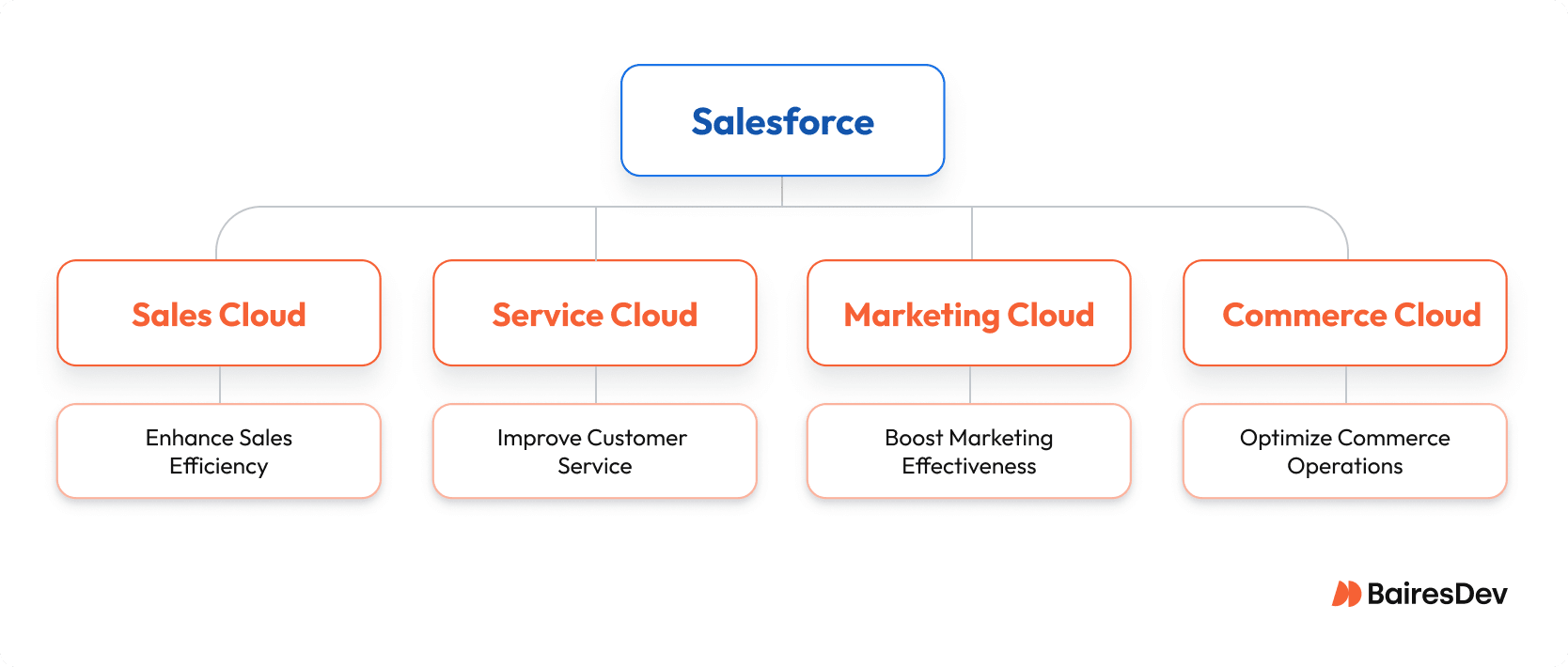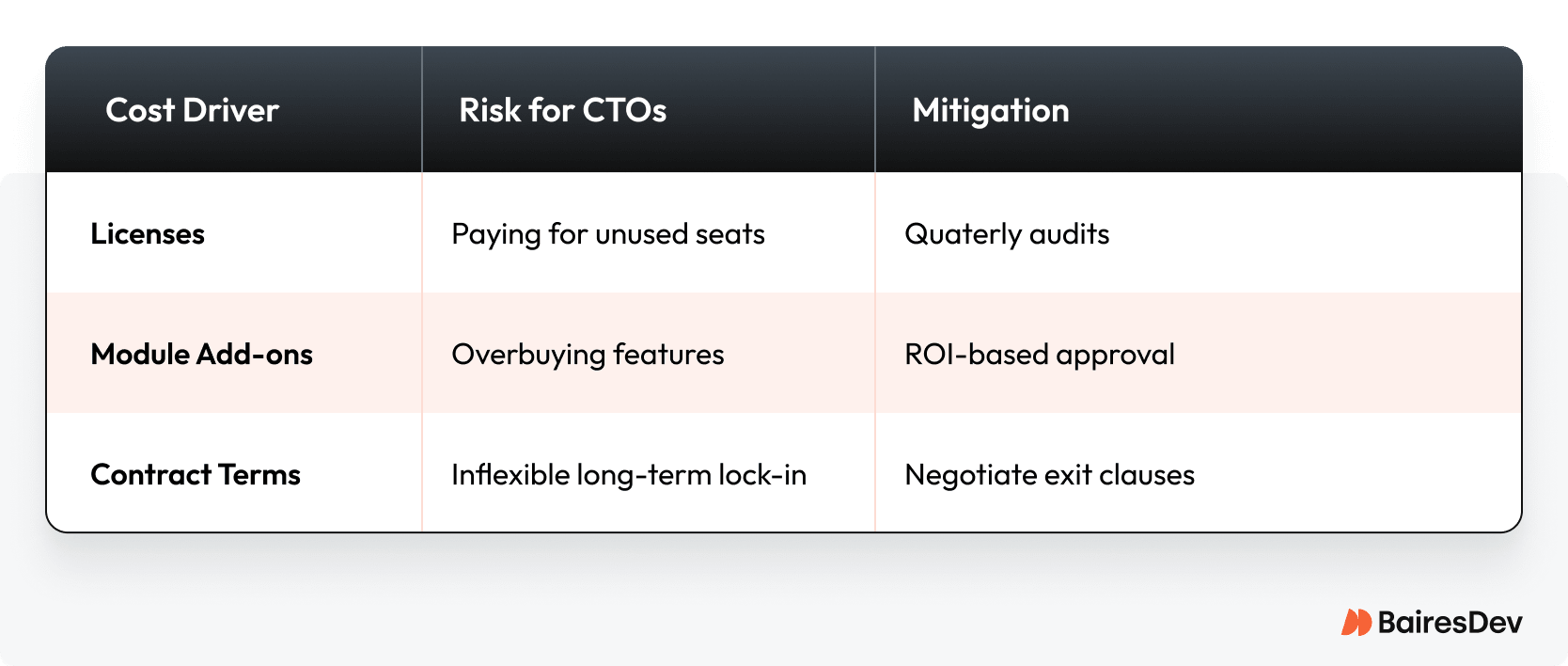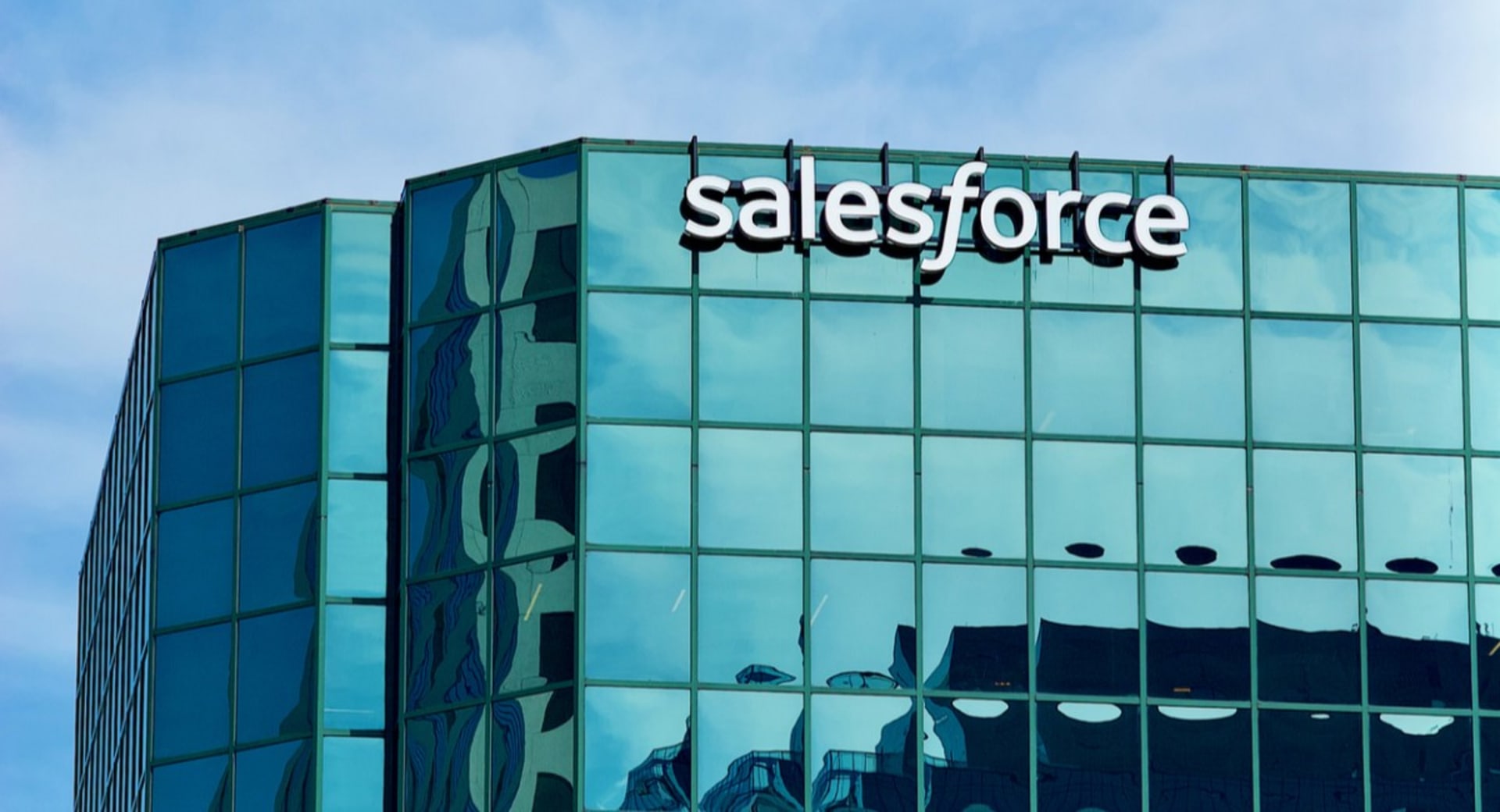Salesforce is a significant enterprise commitment, promising a unified platform for your sales, marketing, and service operations. For many technology leaders, however, that promise quickly collides with a difficult reality.
Deployments can stretch well beyond the six-month mark. Business processes get tangled, and costs balloon unexpectedly. It’s a common story: without clear architectural boundaries, utilization rates plummet while poorly defined admin rights turn the system into an expensive, chaotic experiment.
Marc Benioff may have built a global brand, but this guide is about what it takes to make Salesforce CRM actually work for you. We’ll show you how to avoid the traps, drive cost savings, and deliver results.
What Is Salesforce?
Salesforce is a cloud-based CRM that helps companies manage customer connections. Sales teams use it to track activity and understand behavior in a centralized location. Think of it as the digital brain that coordinates everything from sales conversations to service tickets.

Salesforce uses specialized “clouds” for different functions:
- Sales Cloud
- Service Cloud
- Marketing Cloud
- Commerce Cloud
It includes tools like Einstein, an AI platform that drives analytics and automation. You can customize further with add-ons from the AppExchange marketplace. That follows Parker Harris’ original vision of modular, scalable business systems.
What Salesforce Is Used For
When systems are fragmented, progress stalls. Salesforce gives employees an integrated platform whether they’re in sales, service, or demand generation. For instance, a sales rep can see a support ticket status before a client call, or a marketer can adjust messaging based on recent service interactions.
In coordinating marketing campaigns, Salesforce guides prospects through the conversion funnel. It tracks progress with features like lead qualification and deal velocity. For business development staff, it manages every opportunity stage and improves forecast accuracy with predictive insights backed by Einstein and generative AI.
But it’s more than a process. With apps like Customer 360, it creates a holistic view of interactions between employees and customers. This shared view helps the entire organization respond more effectively to engage end users.
If this sounds like a lot to take in, Trailhead, Salesforce’s gamified learning hub, makes it easier for newcomers to learn to use the system.
Key Salesforce Products and Services
It’s easy to think of Salesforce as “just a CRM,” but it’s a suite of services and products that reach across the framework. Each one is tailored to solve specific operational needs. From sales acceleration to service orchestration and data visualization, companies use this ecosystem to scale.
Sales Cloud
Sales Cloud is the foundational offering among Salesforce products for good reason. It’s built to track every deal and opportunity stage in the sales pipeline. It improves forecast accuracy, supports lead scoring, and automates follow-up cadence so business development teams can save time and close faster. CTOs often integrate cloud modules with external tools for real-time revenue tracking.
Service Cloud
Service Cloud transforms user support from reactive to proactive. It routes cases based on skill and availability, automates responses using Einstein Bots and Flow, and connects with chat, phone, or email support. Salesforce Einstein can analyze case trends and deploy automation triggers. That gives support teams more time to focus on complex services.
Marketing Cloud
Marketing Cloud is the nerve center for marketing campaigns and audience segmentation. It uses data enrichment and behavioral tracking to personalize messages and deploy them across channels. Integrated AI suggests timing and messaging, improving conversion rates. It’s there to more fully sync the sales and service arms of a business.
Commerce Cloud
Commerce Cloud powers e-commerce operations across mobile, desktop, and in-store. From personalized product recommendations to dynamic pricing strategies, it’s built to maximize customer experience and revenue. With robust APIs, CTOs can link it to backend systems, ensuring inventory syncs and fulfillment workflows operate smoothly.
Experience Cloud
Previously called Community Cloud, Experience Cloud allows businesses to build branded portals for partners, employees, or Salesforce customers. It’s often used for self-service, knowledge bases, or even internal collaboration hubs. Its flexible architecture and permissions make it a secure extension of the Salesforce platform.
MuleSoft
MuleSoft is Salesforce’s answer to integration complexity. It allows for API-led connectivity between Salesforce and virtually any third-party system. CTOs rely on it to ensure data flows smoothly across environments, especially in multi-cloud or hybrid architectures.
Tableau / CRM Analytics
Tableau, now part of Salesforce cloud services, gives sales leaders and analysts the power to visualize patterns across the business. It surfaces trends that help executives adjust course quickly. With built-in connectors to Salesforce data centers, it avoids data duplication and streamlines governance.
Slack
After its acquisition by Salesforce, Slack became more than just a messaging tool. It’s now deeply connected with sales, support, and development. Alerts about deals, issues, or campaign milestones appear in real time. For CTOs, it helps align cross-functional teams, especially when layered with Salesforce Lightning automations.
Driving ROI Through Automation
Salesforce automation aligns processes, reduces friction, and increases productivity at scale. For example, you can automate lead follow-ups based on email opens or site visits, keeping reps focused on active prospects. Or trigger case escalations when service tickets sit unresolved, for faster resolution without constant manual oversight.

- Centralized Intelligence: With a unified client profile, decision-makers get unified visibility into clients, teams, and processes. This real-time alignment improves forecast accuracy and enables smarter resource allocation. This is especially helpful when managing vast amounts of customer or case data across departments.
- AI-Driven Insights: Einstein AI delivers real time analytics on buying behavior, service trends, and campaign engagement. From predicting a stalled opportunity stage to fine-tuning your follow-up cadence, it transforms technology into a strategic partner.
- Workflow Orchestration: Trigger-based flows reduce manual handoffs and ensure case resolution speed. Whether it’s automating outreach or coordinating internal requests across third party apps, this kind of automation frees up teams to focus on strategy.
- Scalable Architecture: From small businesses to Fortune 100s, Salesforce’s distributed infrastructure grows with you. That flexibility, championed at events like Dreamforce in San Francisco, supports everything from M&A expansion to onboarding new verticals.
Implementation Pitfalls CTOs Can Avoid
If you live anywhere near Boston, you know the Big Dig’s budget ballooned from $3 billion to over $8 billion. That’s unfortunately how many Salesforce implementations feel. Many rollouts stall because leaders misjudge the complexity. Unless you map third party applications, order management, and IoT Cloud dependencies, productivity suffers and momentum with potential clients can fade.
Underestimating Integration Complexity
Integration isn’t just wiring systems together. It’s building trust between them. Without clear tools for real-time data flow and insights into interdependencies, issues surface late. That’s why Parker Harris emphasized modular architecture when shaping what is Salesforce today.
Over-Customization and Lock-In
It’s tempting to build every process exactly to preference. But excessive tailoring can trap you in the Salesforce environment, making migration costly. Aim for flexible configurations that maintain track progress capabilities without compromising future options.
Buying Before Mapping Workflows
Licenses for cloud modules may look appealing, but without aligning with current technology and personalized shopping experiences, you risk unused capacity. Map workflows first, buy later.
Skipping Change Management
Rolling out Salesforce won’t stick without user training and adoption planning. Equip teams with insights, ongoing support, and a clear Customer 360 strategy. For example, without structured onboarding, staff might revert to spreadsheets within weeks. That can undermine your CRM investment before it gains traction.
Relying on Unvetted Implementation Partners
Many Salesforce rollouts hinge on the effectiveness of third-party systems integrators. A weak partner can misconfigure environments or miss business context entirely. Vet SI partners for enterprise delivery experience and establish escalation paths early. Regular cadence meetings and shared delivery dashboards keep partners aligned with business goals.
Letting Costs Spiral
Without quarterly license audits, costs escalate quietly. Tie spend to measurable ROI, and ensure tools remain aligned with actual usage. For instance, a company might pay for 200 sales module seats but only use 120, wasting thousands each quarter without realizing it.
How Salesforce Works: Architecture & Extensibility
Salesforce runs on a multi-tenant infrastructure. That means all customers share the same core technology while keeping their data secure and private. This design allows developers, admins, and employees to work within one environment, whether they’re at large corporations or educational institutions.
Customization comes through metadata, not hard code. This allows faster updates, easier scaling, and minimal disruption to customer engagement. The Lightning framework supports dynamic interfaces in cloud modules, improving process efficiency.
Robust APIs let the framework sync with other systems, while AppExchange lets users add prebuilt solutions without starting from scratch. From customer information tools to advanced analytics packages, these extensions let CTOs and architects maintain security, compliance, and smooth adoption.
As Satya Nadella might say, good architecture is about enabling people, not just systems. In Salesforce, it’s about using data structures and governance so customers and teams can grow together without losing sight of their mission.
Real-World Use Cases
Salesforce delivers its real value when it’s put to work in real business scenarios. From streamlining sales pipelines to automating service workflows, these examples show how companies use Salesforce to drive measurable results across departments.
B2B SaaS
A B2B software company boosted conversion rates by 25% and cut its average sales cycle by 30% using AI-powered lead scoring. This organization used predictive analytics within a unified sales module to help grow their customer base.
Retail
A leading retail brand implemented Salesforce Commerce Cloud, delivering personalized product recommendations, dynamic pricing, and enhanced mobile-first shopping. Ultimately, they improved customer experience across digital and physical channels.
Service Organization
A research services firm used Service Cloud to automate case routing via a customer portal, connect systems like SAP and MS Project, and trigger escalations based on SLAs, resulting in a 27% reduction in support costs and streamlined user engagement.
Support Efficiency
SupportLogic, using Salesforce capabilities, cut escalation rates by 56% and returned an hour of productivity per support manager, showing the benefit of automated analytics and case management for efficiency and better customer outcomes.
Healthcare
Florida’s Baptist Health used Salesforce Health Cloud to centralize patient records and coordinate care. They connected their EHR systems and saw faster response times and better outcomes. Built on a FedRAMP-authorized and HIPAA-compliant infrastructure, Salesforce supports secure operations in regulated environments without compromising data privacy.
Salesforce Pricing & Licensing
Clear pricing decisions protect resources and keep goals in focus. Understanding cost drivers can prevent overspending while ensuring sales staff, developers, and operations get the web-based capabilities they need.

The Salesforce license model can be attractive, but companies sometimes over-purchase for the sales department or invest in commerce cloud modules before verifying actual need. Here, disciplined “deal desk” review ensures each purchase supports measurable business goals.
In addition, business development leaders must align sales and commerce add-ons with real integration requirements. This avoids spending on capabilities that don’t connect with existing workflows. For CTOs, this is about balancing functionality with sustainability.
Competitors and When to Choose Them
Other CRMs can be good alternatives, especially when companies weigh speed, complexity, and cost. While Salesforce excels at depth and integration, alternatives can offer advantages in specific sales and commerce scenarios.
- HubSpot CRM: Faster onboarding and lower complexity make it ideal for newly acquired units needing immediate operational flow. If sales employees must act before full cloud integration, HubSpot can bridge the gap while developers prepare for larger-scale transitions.
- Zoho CRM: A cost-effective choice for SMB divisions where connection demands are light. For companies that see Salesforce as too large for the task at hand, Zoho offers essential sales functions without heavy architecture. This is ideal when developers are scarce.
- Microsoft Dynamics 365: With Satya Nadella’s focus on a unified cloud ecosystem, this is the natural choice for organizations standardized on Azure and Office 365. It supports deep sales analytics and commerce combinations without leaving the Microsoft stack.
- Walk Away: If total cost of ownership (TCO) outweighs projected enterprise gains or embed costs feel prohibitive, stepping back is sound pipeline hygiene.
CTO Playbook for Long-Term Success
Long-term success with Salesforce comes from consistent execution. For CTOs, that means treating the platform as a living system: audited regularly, aligned to strategy, and governed across teams. For example, a CTO might schedule quarterly audits to prune unused licenses and automation triggers, keeping the system lean and efficient. Or they might standardize customization requests through a KPI-aligned review board to avoid technical debt.
- Maintain an integration registry: Track every connection between Salesforce and cloud systems. This prevents hidden dependencies that can create lock-in and limit future agility.
- Audit licenses and automation quarterly: Leaders need to align resources with outcomes. This includes monitoring, automation triggers, and developer contributions.
- Align customizations with strategic KPIs: Avoid designing features for individual requests. Instead, ensure your rollout boosts sales performance and supports Commerce Cloud growth objectives.
- Keep governance cross-departmental: Foster collaboration across sales, marketing, and commerce functions to improve forecast accuracy and operational cohesion.
- Align with Sales Ops and Finance: These teams define revenue models and quotas. Involve them early to ensure reports that go beyond mere technical configurations.
- Leverage Dreamforce and Trailhead: Use these resources to keep developers and teams engaged in continuous learning, so the system is a strategic asset rather than static.
Salesforce Isn’t a Tool
So let’s be clear. Salesforce isn’t a tool. It’s an engine. And if you don’t treat it like one, it will eventually seize up.
Forget endless customization—that’s a trap that creates technical debt. Your real job is disciplined governance. That means you ruthlessly measure ROI. You have to obsess over the workflows that actually drive value. And you must maintain a simple roadmap that doesn’t lock you in. It’s as simple as that.






